Bookstore
Welcome to ScytheSupply's Bookstore. Here you will find publications that we enjoy and find useful. We welcome suggestions.
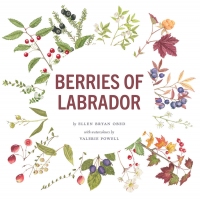 Berries of Labrador
Berries of Labrador
 Grasses: Versatile Partners for Uncommon Garden Design
Grasses: Versatile Partners for Uncommon Garden Design
 The Organic Grain Grower
The Organic Grain Grower
 Weeds and Wildflowers in Winter
Weeds and Wildflowers in Winter
 The Scything Handbook
The Scything Handbook
 Twelve Kinds of Ice
Twelve Kinds of Ice
 Small Scale Grain Raising
Small Scale Grain Raising
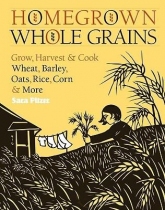 Homegrown Whole Grains
Homegrown Whole Grains
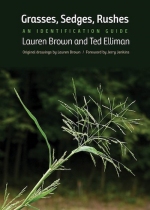 Grasses, Sedges, Rushes: An Identification Guide
Grasses, Sedges, Rushes: An Identification Guide
 Barns and Outbuildings: And How To Build Them
Barns and Outbuildings: And How To Build Them
 The Scythe Book
The Scythe Book
 Handy Farm Devices: And How to Make Them
Handy Farm Devices: And How to Make Them
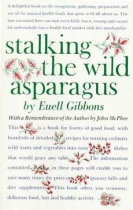 Stalking the Wild Asparagus
Stalking the Wild Asparagus
 The Apple Grower
The Apple Grower
 Fences, Gates and Bridges: A Practical Manual
Fences, Gates and Bridges: A Practical Manual
 Field Guide to the Grasses, Sedges and Rushes of the United States
Field Guide to the Grasses, Sedges and Rushes of the United States
 The Ax Book
The Ax Book
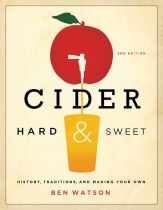 Cider Hard & Sweet
Cider Hard & Sweet
 The Wild Wisdom of Weeds
The Wild Wisdom of Weeds
 Wild Plants I Have Known… and Eaten
Wild Plants I Have Known… and Eaten
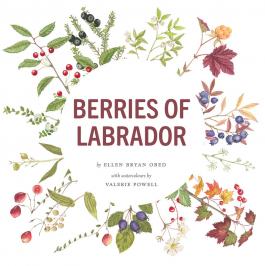
Berries of Labrador
Berries of Labrador combines storytelling with science to celebrate more than forty species of berries and their various uses, from food to medicine. Beautiful watercolor illustrations by Valerie Powell and short anecdotes from community members accompany each description, highlighting the cultural, historical, and ecological significance of the berries of Labrador. This significance spans regions and countries, with thirty-seven of the forty berries found in the state of Maine.
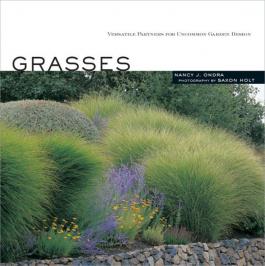
Grasses: Versatile Partners for Uncommon Garden Design
The photos are lovely. The text is thorough with descriptions and possibilities integrating grasses with landscaping. Grasses by Nancy Ondra is a refreshing perspective of the versatility of cover crops, ornamental grasses and companion planting.
The suggestions are many for edging, color combinations and all seasons. There is something for every gardener between the covers. Grasses is worthwhile for study as well as browsing for new insights into gardening. Hesitate before mowing the showy varieties described within.

The Organic Grain Grower
The Organic Grain Grower is invaluable for both home-scale and commercial producers interested in expanding their resiliency and crop diversity through growing their own grains. Longtime farmer and organic pioneer Jack Lazor covers how to grow and store wheat, barley, oats, corn, dry beans, soybeans, pulse crops, oilseeds, grasses, nutrient-dense forages, and lesser-known cereals. In addition to detailed cultivation and processing information, Lazor argues the importance of integrating grains on the organic farm (not to mention for the local-food system) for reasons of biodiversity and whole farm management.
Beginners will learn how to grow enough wheat for a year’s supply of bread flour for their homestead, and farmers will learn how to become part of a grain co-op, working alongside artisan bakers and mills. Never before has there been a guide to growing organic grains applicable both for the home-scale and professional farming scale.

Weeds and Wildflowers in Winter
Back by popular demand, Lauren Brown's Wildflowers and Weeds in Winter is a fun and informative winter read. You will be ready this Spring to identify the vegetation as it comes alive in your back yard and fields. With helpful illustrations and in a well organized format, this book presents 135 common species in the Northeastern US.

The Scything Handbook
Ian Miller’s The Scything Handbook is more than an introduction to mowing with a scythe; it’s an appeal to reconnect with and ideally heal our environment.
In a warm conversational tone Miller reminds us that using the right tool is elegance. Not only does it get the job done with a minimal effort, mowing with the scythe supports the life around it.
The information is presented in nine chapters, and covers three main topics: the scythe, haying, and growing grain. The first and largest portion of the book is an introduction to the scythe. The topics proceed logically from scythe assembly and mowing basics, to blade repair, with an insightful chapter titled, “Getting the Best from your Body.”
In the second portion of The Scything Handbook, Miller introduces us to the joys and challenges of haying by hand. Information includes timing the mowing, hay rack design, nutrient loss, and storage.
The final topic is growing and harvesting small grains. The flavor of freshly harvested grain berries can’t be overstated. As heavenly as is a bite of warm buttered bread from the oven, bread made with freshly harvested grain is exponentially better. Miller is careful though to communicate just how labor intensive small scale grain raising is. Read it and decide for yourself.
This book is not available in print anymore, but can be purchased as an e-book using this link!
https://newsociety.com/?swp_form%5Bform_id%5D=1&s=Scything+handbook

Twelve Kinds of Ice
When your scythe is put away for winter months, that backyard garden plot or level hay field could become a skating rink! A family on a small farm in Maine enjoyed this tradition every year. The eager anticipation of waiting for ice, followed by the joy of having the perfect skating rink in the backyard, unfolds in this delightful book by Maine author Ellen Bryan Obed.
Scythe Supply is happy to offer Twelve Kinds of Ice to its customers for no better reason than that the author is the sister of Scythe Supply's owner.
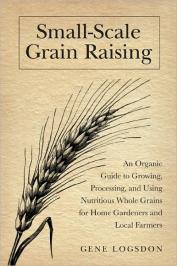
Small Scale Grain Raising
Scythe Supply is delighted to have in stock the recently published 2nd edition of Gene Logsdon informative book guide to growing, processing and using nutritious whole grains.
This book is the resource for which we have been anxiously waiting!
Go forth and plant your 'Pancake Patch' this Spring or Fall!

Homegrown Whole Grains
Originally published in 1981 as Whole Grains, Harvest & Cook Your Own, the new version is a refreshing update for those of you embarking on growing your own grains. Part of your yard can be converted into a productive and beautiful field of grain. How to prepare your soil for planting and months later how to prepare delicious recipes for your harvest are both covered in this well organized and informative book.
Scythe Supply is glad to welcome back Sara Pitzer's helpful guide.

Grasses, Sedges, Rushes: An Identification Guide
Grasses: they are everywhere! The identification of these ubiquitous plants can be a challenge. This recently published updated and amended revision of Lauren Brown's book is excellent and can assist you in the ID challenge. It is portable, user friendly guide with line drawings as well as clear photographs. Carry it in the field with you along with your whetstone, holder and scythe!
Over 100 species are included with an emphasis on the Northeast and Midwest but is applicable to anywhere in North America.
Scythe Supply is excited to have this book available. 'Know what you mow!'

Barns and Outbuildings: And How To Build Them
PLEASE NOTE: Barns and Outbuildings is now Out Of Print. Lightly used copies we have procured from other sellers may contain library stamps/stickers/barcodes, light smudging on exterior, and/or clear tape on spine/cover.
Originally published in 1881 as a guide for Homesteaders, Barns and Outbuildings remains a useful resource 100+ years later. Plans, instructions and clear pen & ink drawings for barns, poultry houses, dog, bird & smoke houses plus root cellars are all included.
Anyone keeping animals or contemplating the addition of a livestock to one's household will find this book an integral part of the planning and dreaming process. The resulting structure will have your livestock residing in sturdy, efficient and safe structures. The bird house section is grand and the houses appear welcoming for the creatures of flight on your farm. The dog houses are sturdy and functional.
Food storage for human consumption as well as silage is extensively included with designs for cellars, bins and silos.
In the forward to the previous edition Castle Freeman outlines the virtues of this delightfully useful book:
- Light and Air - the importance of sunlight and ventilation in keeping animals.
- Space - livestock will be healthier and have room to grow with added space.
- The Cost - estimates are of another era but remind us that with careful consideration an economical but well designed building is priceless therefor a virtue.
- Convenience - the siting of the building, floor plans and construction all can equate to efficiency making the daily operations of a homestead more manageable.
- Beauty - the buildings are all pleasing to the eye and even simple building when well done adds to the landscape.
If your dreams are only that of a new woodshed, Barns and Outbuildings is enjoyable to read and may have you planning for larger projects.
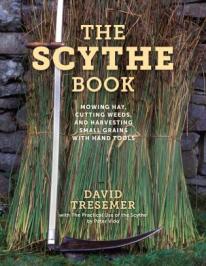
The Scythe Book
This first edition released by a new publisher in 2021 has all of David Tresemer's original text and addendum by Peter Vido, with an updated layout and larger illustrations. The combined writings of the authors gives us the insight and instruction that will make this tool sing. This is a must-have book for scythe enthusiasts. Reviews at Amazon. (Original copyright 1981; addendum 2001).
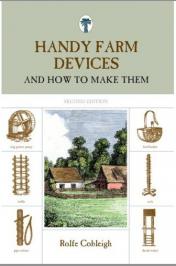
Handy Farm Devices: And How to Make Them
Handy Farm Devices is both tribute to the kind of ingenuity that built America and a resource for present-day homeowners striving to become more self-sufficient. Here are hundreds of clever ways to transform your home, farm, or ranch using items lying about your yard or material readily available at any hardware store or lumberyard. You can build a homemade water cooler, a folding chicken roost, a garden stool, a fruit picker or even small, sturdy bridge for crossing s stream on your property.
First published in 1910 it is a classic in ingenuity.

Stalking the Wild Asparagus
Since its first printing in 1962, Stalking the Wild Asparagus is a favorite of foragers and those interested in eating off the land. It is applicable to edibles in one's backyard or in the deep woods. Recipes compliment the identification and gathering information. Euell Gibbons presented us with a timeless handbook and guide. We are grateful to Alan Hood publishing for keeping this book in print.
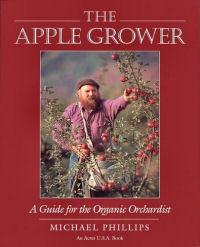
The Apple Grower
Apples represent "organic's final frontier" for many backyard and commercial growers. Yet despite the challenges, it is possible to grow healthy, flavorful apples with little or no need for synthetic chemicals. In The Apple Grower, author and organic orchardist Michael Phillips combines the forgotten wisdom of our great-grandparents with the best research and techniques available today. Having an orchard and using a scythe go hand-in-hand. The areas under the apple tree are best mown with a scythe, whether with a grass or ditch blade. Along with the bountiful information in The Apple Grower, Phillips, as well as Scythe Supply, recommends a scythe for orchard maintenance.

Fences, Gates and Bridges: A Practical Manual
Fence it in. Fence it out. Surround, protect or decorate. This practical manual originally written in 1887 and published again in 1992, 105 years later, shines as a trusty resource for simple to complicated fence building. Rail, sod, board, picket even barbed wire fences are all here. Plus the gates, fastenings, wickets and stiles needed for getting in and out and up and over are all here. This useful book will come in handy when there’s errant livestock to keep in or hungry wildlife to keep out. For vegetable and flower growing a section of a fence may be just what the climbing vines of sweet & edible peas, morning glories, cukes, gourds and beans need to stretch and display their growth.
The clear pen and ink drawings from another century are appropriate for any era. The copy is straight forward and clear.
If you don’t have a fence or gate before reading this book, you just may come up with a reason to have these additions to your landscape. Then you will need to mow around the structures with a scythe!

Field Guide to the Grasses, Sedges and Rushes of the United States
Know what you mow - wild or cultivated, common or not-so-common. Here is a wonderfully clear, concise guide to over 370 species of grasses, rushes and sedges of the United States Each entry includes the common and botanical name of the species -its habitat, height, color, description and a line drawing of plant and spikelet. A book for the mower, the grower, the amateur botanist, or anyone who simply wants to know the grasses.

The Ax Book
I've used an ax a lot since I was a kid (trust me, that's a long time) but The Ax Book has given me ideas I never would have thought of. This is the perfect book for the novice or the experienced woodsman. If an ax can do it, or shouldn't do it, I think it must be covered here - types, selection, safety, sharpening, felling, bucking, splitting, making and hafting a new handle, and if you have a woodlot how to get the most out of it and keep it productive. Cook even explains how to stack and store your firewood. There are several excellent chapters on felling and bucking with bucksaw and crosscut saws and sharpening, too, for those of you who want to forgo the ear splitting, whirling chainsaw. For those who use one, that wild beast is covered here, too. Clearly written everyday prose is supported by scads of detailed Eric Sloane-type drawings which alone make this book worth owning.

Cider Hard & Sweet
A bountiful book filled to the brim with historical anecdotes of cider and instructions on how to make both the sweet and hard versions of this popular beverage. This new edition is an entertaining and informative celebration of our nation's first drink, which is now receiving renewed and well-deserved attention.
A glass or mug of cider is especially delicious upon viewing newly made windrows of Fall mowing.

The Wild Wisdom of Weeds
A weed is a plant growing where you don't want it to grow - so it can be said of all the 13 plants mentioned in this book. The author presents the 13 ubiquitous plants as nutritious, tasty healers and a boon to all. Recipes and medicinal uses are described. This book encourages the reader to go out and forage, prepare and consume instead of pull out and discard.
As a conscientious forager and promoter of responsible human-earth connections, Blair shares her vision of the 13 weeds as plants to harvest and cultivate for human health and survival. Sandor Ellix Katz presents an insightful forward, and then Katrina Blair follows with an informative guide.
A Scythe Supply hint is that all of them are easily harvested with a scythe. Here's to the weeds!

Wild Plants I Have Known… and Eaten
Inspired by an Edible Botany course taught by his sophomore biology teacher, Russ Cohen became a life-long enthusiast of foraging wild foods.
Wild Plants I Have Known… And Eaten is presented in four parts. Parts One and Two share the copious benefits of harvesting wild foods, from spiritual uplift to family bonding, as well as the basics of safely identifying, collecting and processing plants. The balance of the book is dedicated to a lively romp through shaggy areas, edges, mushy places and sunny fields and is organized chronologically, spring to winter, according to when each plant is ready for harvest.
As you peruse the photos, descriptions and “profiles” of each plant, you will probably find that these tasty treats have been with you all the time. You may find yourself grabbing those nearby and exclaiming, “Hey! I pull that out of my onion patch every spring!” Proving the author’s main point that foraging is fun, my co-worker said, “This generates a lot of good conversation!”
It may be that some of those plants in your scythe’s windrow could well go in your evening salad or soup. (Recipes provided).
Videos

Peening the European Scythe VHS
Same as the Peening & Sharpening video available on our videos webpage, but in good old VHS format.

 Peening the European Scythe VHS
Peening the European Scythe VHS